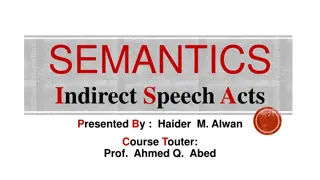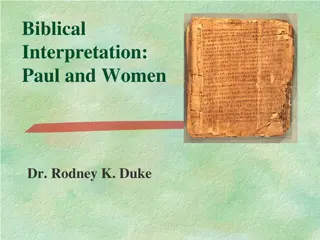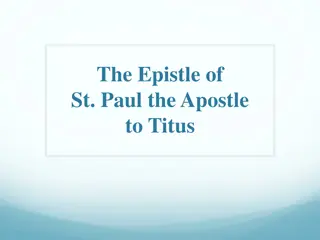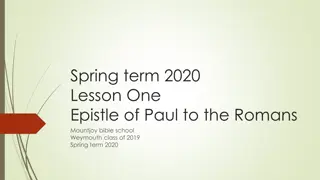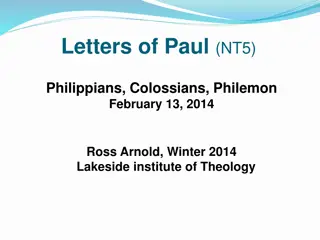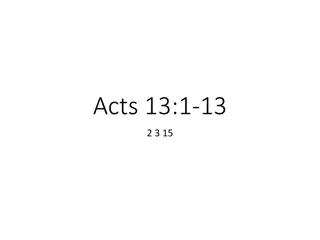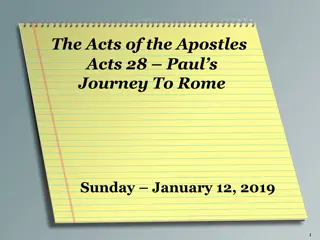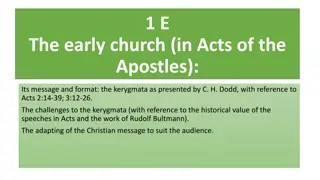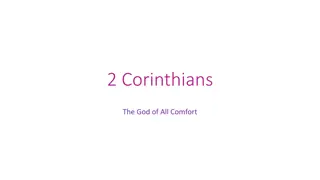Understanding Acts and Paul's Epistles: Insights and Context
Delve into the Acts of the Apostles and the Epistles of Paul to uncover their significance, theological themes, historical context, and unique challenges in interpretation, providing valuable insights into the early Church's development.
Download Presentation

Please find below an Image/Link to download the presentation.
The content on the website is provided AS IS for your information and personal use only. It may not be sold, licensed, or shared on other websites without obtaining consent from the author. Download presentation by click this link. If you encounter any issues during the download, it is possible that the publisher has removed the file from their server.
E N D
Presentation Transcript
Introduction to Acts and the Epistles of Paul
Introduction We will study the Acts of the Apostles and the 14 Epistles of Paul including: Their character The unifying theological themes The historical and theological background
Introduction (Cont) The problem with studying the Pauline Epistles: People do not understand the historical setting behind each epistle which would be like reading a stack of emails without knowing: Who the author is Where and when they were written What was going on in the author s life Who was the intended audience Who was the recipient
Introduction (Cont) Because Paul dictated his letter to a scribe, and due to the cost of parchment, he could not go back and make corrections Therefore, he had to correct his mistakes in the next dictated line These correction sometimes cause confusion but they also authenticate that the letters are real letters written by a real person
Introduction (Cont) What order do Paul s letters appear in the Canon of Scriptures? They are listed, like the books of the Prophets in the Old Testament, from the longest to the shortest (Not in a historical time line!) This was the way the early Church laid them out in their lectionary The historical setting for Paul s epistles can be found in the study of the Acts of the Apostles (thus we will jump back and forth)
Introduction (Cont) Acts of the Apostles Title: may not have been the original name of the text Author: Date of composition: to 68 A.D. Book ends with Paul s imprisonment in Rome in 62-63 A.D. Contains no information about the martyrdom of Peter and Paul in 67-68 A.D. or the destruction of Jerusalem in 70 A.D. Title: English translation from Latin and Greek Author: Luke Date of composition: sometime after 62 A.D.
Introduction (Cont) Major Themes and Structure As given in chapter one But you shall receive power when the Holy Spirit has come upon you; and you shall be my witnesses in Jerusalem and in all Judea and Samaria and to the end of the earth (Acts 1:8) The book chronicles the spread of the gospel by the power of the Holy Spirit through the Apostles, the witnesses of the resurrection, beginning in Jerusalem and Judea (1-7), then to Samaria (8-9), and then into the Gentile world (10-28), over a span of about thirty years Major Themes and Structure
Introduction (Cont) Significant Content of Acts First important and detailed information about the Holy Spirit and his workings with the early Church Second of the Apostles, we are able to see the content and style of preaching in the early Church Significant Content of Acts First, it provide some of the most Second, through the many public Speeches
Introduction (Cont) Third early Church structure to include: Deacons, Priests, Bishops, the Episcopal office and the Apostles Forth Church council to include: The paradigm The debate, decision and public pronouncement through a written declaration, by which the Church will resolve doctrinal and practical problems throughout her history Third, it provides a number of examples of Forth, it provides the occurrence of the first
Transition Next we will begin with an introduction to the Book of the Acts of the Apostles Book of the Acts of the Apostles






